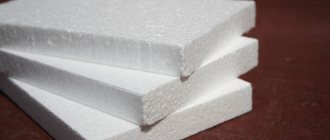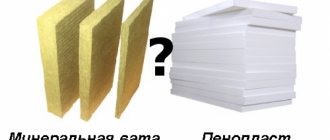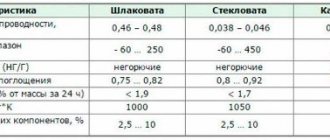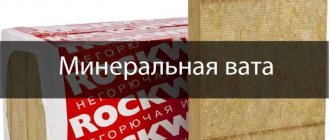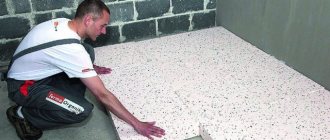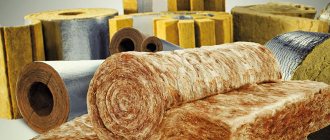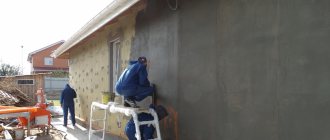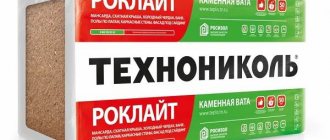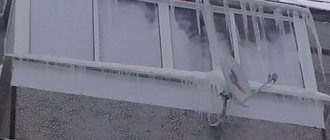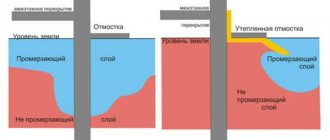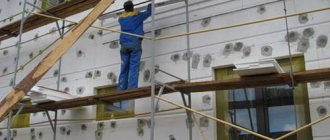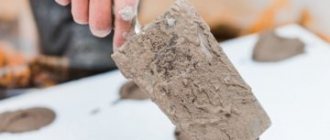Insulation of the facade with mineral wool
The popularity of insulating the facade of a house with mineral wool is due to the many advantages of this material. It has many useful properties that make home insulation effective. Mineral wool is often used to decorate the exterior walls of buildings and serves as a good insulation material. It is lightweight, extremely easy to install, and also demonstrates excellent thermal insulation characteristics. It is also worth noting its reasonable price. You can install it yourself if you have a good understanding of the technology and the nuances of the process. The technology of facade insulation involves the use of various insulating materials, among which mineral wool takes pride of place. The material is able to perfectly protect the external walls of buildings from freezing. This is the best option for a ventilated facade system made of stone or porcelain stoneware. This type of insulation is also used for wet facade technology. Buying it won't be difficult. In Moscow, mineral wool slabs are presented in a wide range.
Wet facade
It was already said above that mineral heat insulator slabs must be glued to the wall surface with special glue for facade work. Mechanical fasteners will also be used. The combination of these techniques can significantly increase the strength of the entire structure, which will allow it to cope with the load that the decorative finishing layer will exert. This can be clinker tiles or plaster.
Let's try to understand the insulation scheme and the features of the production of “wet” insulation technology for the facade of a house using mineral wool.
The initial stage involves preparing the base for laying the insulator:
- it is necessary to get rid of any hanging structures and fasteners;
- remove the remnants of the previous decorative layer, if any;
- cover up all defects - potholes and cracks;
- eliminate old stains and existing dirt.
Varieties of mineral wool
The modern construction industry uses three basic types of mineral wool, each of which has its own unique characteristics:
- Glass wool - is light in weight, has a fibrous structure, consists of very thin glass threads, the thickness of which can reach 15 microns. The fiber length ranges from 15-50 mm. Thanks to special raw materials, glass wool becomes elastic and durable. It is necessary to remember safety precautions when working with glass wool. It poses a danger to the eyes and lungs, so when installing it you must use goggles, a respirator and gloves. This insulation can withstand heating up to 450°C. Insulating a glass wool ventilated facade is a popular trend among owners of a private house or cottage.
- Slag wool is one of the types of mineral wool, widely used for various structures and structures. Made from blast furnace slag, the fiber thickness can be up to 12 microns and the length is approximately 16 mm. It is not used for facade work and is not suitable for pipelines due to its good hygroscopicity. Just as in the case of glass wool, you need to be careful when working with these slabs. Protect your eyes and lungs. This type of material can withstand high temperatures up to 300°C. If you lay slag wool tightly and efficiently, you can create excellent thermal insulation for external walls.
- Stone wool - technical characteristics are similar to the previous type of insulation. The obvious advantage is that the fibers are not brittle and are not subject to crumbling. Stone wool can withstand heating temperatures up to 600°C. This type is most often used when insulating the external walls of buildings. It consists of clay, limestone, blast furnace slag and dolomite. These components impart fluidity and reduce the percentage of binding components, making stone wool safer for human health. It is often used to insulate external walls and when constructing a ventilated façade. You can purchase stone wool at any specialized store.
- Basalt. This variety is made from gabbro-diabase, does not contain additives, and tolerates heating temperatures up to 1000°C. Features a long service life. The material can be purchased commercially in various forms: sheets, rolls, mats. No additional inclusions are involved in the production of basalt slabs. This production technology makes it possible to achieve resistance to high and low temperatures. This is an ideal option for insulating walls outside. Buying basalt wool in Moscow is very simple. It can be bought at any hardware store.
When purchasing a mini-slab in Moscow, you should pay attention to the level of quality, because the durability and reliability of the facade system will depend on this in the future.
Properties and characteristics of mineral wool
Mineral wool is made from rocks. Depending on what exactly was used, different subspecies are called basalt wool, glass wool, stone or slag wool. Common properties of all subspecies:
- Lightness - the structure is not overloaded, it is possible to use any facade construction technologies:
- Porosity – the material allows air to pass through and does not allow moisture to condense;
- Air cushion - due to the porosity of the material, it helps to insulate the room from cold and noise from the street;
- Softness - mineral wool bends and cuts, it can be used on facades of complex shapes;
- Chemical inertness – does not react with aggressive acids and alkalis, does not corrode or rot;
- Biological inertness – is not a convenient environment for the proliferation of microorganisms, but is safe for health;
- Heat resistance and fire resistance - does not heat up well, does not melt, almost does not burn;
- Long service life - 20-50 years. All this time, mineral wool does not change its properties and does not release toxic materials into the environment;
- Sharp cuts are the only property that can be considered a disadvantage. The edge of the slab or its breaks may injure unprotected skin.
Also, some types of mineral wool can release formaldehyde products upon strong and prolonged heating. This does not apply to basalt and stone wool - they are completely safe.
Mineral wool brands
Before insulating a facade with mineral wool, you should study its brands:
- P-75 - most often used for thermal insulation of horizontal wall surfaces. The density of these mineral wool slabs is not sufficient for resistance to mechanical stress. For this reason, they are most often used for roofing and attics. Can also be used for various pipelines.
- P-125 - used in the process of finishing work indoors. Retains heat well and provides good sound insulation. A ministove of this brand can protect premises from extraneous sounds.
- PZh-175 – increased density and optimal rigidity. Area of use: insulation of walls and ceilings made of metal or reinforced concrete.
- PPZh-200 is the optimal option for rigidity and strength, used for structures made of reinforced concrete and metal.
Features of installation of mineral wool
Mineral wool and ventilated facades are the most common method of insulating premises. The slabs are placed close to the load-bearing wall, and the “dew point”, i.e. the area where condensation appears is outside the insulating layer. And the insulation itself protects the ventilated gap between the frame of the external structure and the wall with insulation from excess moisture. For this reason, only non-combustible materials are allowed to be used in ventilated facades, otherwise ideal conditions will be created for the spread of fire.
Safety precautions when working
The material is considered safe - no special working or protective equipment is required, you can install the facade with your own hands (in a private house, in a country house). However, some safety rules remain:
- To work, you need fully covered clothing and shoes, gloves (fabric or rubber), and a headband. Cotton wool crumbles, and its smallest particles can prick unprotected skin for a long time and painfully;
- You can cut slabs only with a sharp knife - this way the cuts are smoother and there are fewer small particles in the air. Reduces the risk of cutting yourself with an uneven edge;
- If the technology requires grinding slabs (as well as those with sensitive mucous membranes), a respirator and safety glasses are needed to prevent small particles from getting into the respiratory tract and eyes;
- After work, you need to immediately undress, take a shower and put on clean clothes;
- Clothes that were used to work with mineral wool cannot be stored together with other clothes - they must be washed first.
If all precautions are taken, but an hour after work you still feel discomfort, you should take another shower and change clothes. The appearance of itching, redness, coughing, watery eyes - consult a doctor.
Windproof film
Mineral wool has one serious drawback - it is easily destroyed by constant wind. This threatens to deteriorate the thermal insulation and sound insulation of the house, and sharp and small particles enter the environment, which can cause irritation of the skin and mucous membranes. Therefore, a special windproof film is used in the installation of ventilation facades. It is mounted on top of the slabs and covers them from the gap side.
The characteristics of windproof film are high strength and elasticity. Thanks to them, it doesn't tear. This material also allows moisture to pass through, so it does not interfere with the mineral wool’s ability to perform its insulating properties.
Fastening thermal insulation
The mini-plate for ventilated facades is secured using dowels. Due to the large size of the cap, they are called dish-shaped. For each dowel you need to make a hole in the wall with a depth of at least 30mm - this way a reliable fastening is achieved. For each subsequent layer, the fasteners must be longer. The last layer is fixed together with the windproof film.
To correctly position the slabs, lay out the mineral wool insulation on the façade in advance. The slabs are positioned as they should be, holes for mounting dowels are marked - in the corners of each slab. For the outer layer you need one more fastening - in the center.
Benefits of using mineral wool
Insulating the facade with mineral wool under siding has a number of advantages:
- Allows you to protect the walls of the house from gusts of cold wind, making the rooms inside cozy and warm.
- It insulates walls well outside.
- It is not subject to combustion and is not a source of toxic smoke when melted.
- Facade systems insulated with mini-plates are resistant to moisture.
- Providing sound insulation.
- The service life exceeds the service life of other materials, including foam.
- Durability of use.
- Resistance to various types of damage.
- Not susceptible to deformation.
- Good thermal conductivity.
- Fire safety.
- UV resistance.
- Highest level of vapor permeability at any density.
- An affordable way.
- Safety for the external environment.
- Resistant to the development of mold and mildew.
- Resistance to temperature fluctuations.
Insulating the facade with mineral wool allows you to provide a comfortable optimal microclimate in residential premises. Before purchasing, it is better to consult with an experienced specialist who will accurately determine the level of quality of the product, since the service life of the entire facade will largely depend on this.
The main properties of mineral wool
Mineral wool is used to insulate canopies indoors and outdoors. This was made possible due to the following insulation qualities:
- Low level of thermal conductivity, due to which heat losses are minimal, and in summer the air temperature outside has virtually no effect on the atmosphere indoors.
- Non-flammable - it can withstand high temperatures and does not ignite. When smoke occurs, no toxic substances will be released.
- Vapor permeability - the material can release vapor absorbed into the atmosphere, thereby preventing the proliferation of pathogenic microscopic organisms.
- Sound insulation - the fibrous structure of mineral wool perfectly retains extraneous noise and also prevents it from entering the building.
- Chemical passivity - due to this, corrosion does not develop when the metal comes into contact with the insulating layer.
Mineral wool is completely fireproof, has high vapor permeability and excellent water-repellent properties. Before insulating a house with mineral wool, you should study all its advantages and disadvantages, and also determine whether it is rational to use it specifically in your case.
Advantages
The advantages of the material for thermal insulation are obvious, as they arise from the technical parameters:
High level of thermal insulation due to low thermal conductivity coefficient.- Safety for human health due to fire safety and resistance to aggressive substances.
- Durability due to high level of strength.
- Easy to install due to the flexibility of the material.
- Versatility - suitable for surfaces of any type (aerated concrete, wood, etc.), in addition, mineral wool is used not just for facades, but also for attics and floors.
When choosing thermal insulation materials for a future building, you need to find out about all its pros and cons. Based on the advantages listed above, insulation with mineral wool is a very effective method of thermal insulation, which helps to save significantly.
Flaws
Along with its positive qualities, mineral wool also has some disadvantages that limit its range of applications:
- When installing, you must strictly adhere to the recommendations from the material manufacturer.
- Despite the low level of hygroscopicity, cotton wool can absorb moisture, and this negatively affects its quality characteristics, and therefore requires additional consideration of waterproofing.
- The many offers on the market create the risk of purchasing low-quality products, which can be toxic and, therefore, dangerous to human life.
- Due to the structural features, it is necessary to carry out insulation work in special clothing in order to protect the skin and mucous membranes.
- The cost of mineral wool is higher than that of polystyrene foam, but the price is fully justified, since its quality and strength parameters are much higher.
The material is often used for insulating floors and roofing structures. The disadvantages are conditional, and by choosing a high-quality insulating material, as well as following the installation technology, you can achieve excellent results.
Technology of facade insulation with mineral wool
Below we consider the main stages of insulating a facade with mineral wool:
- At the first stage, preparatory work is carried out. The surface is carefully prepared, unnecessary objects are removed, metal elements are dismantled, which will be installed in the future only after a comprehensive finishing cladding. The working surface should not have nails or other parts. The reliability of the plaster also needs to be studied and the layer removed in areas where it has moved away from the surface.
- The next stage of work is the development of a detailed action plan. For those who want to do the work themselves, it is better to try laying mineral wool on a small area of the wall in an inconspicuous place.
- An important stage of work is priming the surface. Professionals recommend using special deep penetration formulations. If there is mold or fungus has formed, it is best to use special products. To properly perform priming, you should use a wide brush to make it convenient to apply the primer.
- In order to lay the insulation evenly, it is necessary to create a sag map, which will allow you to divide the workspace into specific zones. In these areas, using a standard nylon cord, sags are made horizontally, vertically and diagonally. The sags must be installed in such a way that the distance between the cords does not exceed 90 cm.
- The first row of insulation is installed strictly in the horizontal direction.
- The next stage of facade insulation with mineral wool is the installation of a guide profile, which serves as support for the first row of mineral wool, and also provides the necessary gap between the insulating layer and the wall surface. To install this profile, a level, dowel, mesh, and glue are used. Before installation, find the zero point using a water level. Usually the profile is secured with a dowel.
- Directly the insulation stage. First you will need to prepare a special adhesive composition.
- The glue, ready for use, is applied to the insulating boards and distributed evenly over the entire surface. It is necessary to pay attention that applying glue pointwise in a particular case will not allow the insulation to be securely fixed to the wall.
- After the slabs are completely covered with the composition, they are applied to the facade, placing the lower edge on the base profile. Using a water level, you can check the evenness of the slabs. Subsequent slabs are laid on the wall using a similar method.
- After fixing the first row of slabs on the wall, they must be secured using disc dowels. This will ensure a secure fit. No matter how high-quality the adhesive solution is, the use of fasteners when installing insulation is mandatory. For slabs located above the fifth floor, the number of fasteners will be at least seven.
- After all the insulation boards are fixed, it is necessary to eliminate all existing gaps by covering them with putty.
- Then the surface is reinforced with a facade mesh, after which glue is applied to it. Next to the first section of the reinforcing mesh, a second section is laid, and an overlap is made between the layers. To ensure absolute evenness of the wall, before reinforcement it is covered with a thin layer of plaster. This method will allow you to mask minor defects.
- After the plaster has completely dried, the finishing cladding is performed.
The technology for insulating mineral wool under plaster is absolutely simple, but it is better to entrust such work to professionals who will perform the task competently, accurately and quickly.
Main stages of installation
Insulation with mineral wool under plaster is carried out in four successive stages.
Preparing the base
Before laying the heat-insulating layer, the base is prepared. If the building is new, it is enough to simply treat the surface of the walls with a primer. This will increase adhesion and protect the substrates from high humidity.
Sometimes careful preparation is needed, which is done as follows:
- Cleaning the surface from contamination. It must be wiped off with a brush to remove dust and dirt.
- Plastering. The cleaned surface is covered with a thin layer of plaster to hide unevenness and roughness.
- Primer. When the plaster hardens, a primer layer is applied to it.
Fixing the insulation
First, the insulation is glued to the wall surface. It is necessary to use adhesives that are suitable for outdoor use. You also need to make sure that the chosen glue is suitable for mineral wool.
The prepared adhesive solution must be applied to mineral wool. Then the treated material is applied to the base and held for 5-10 minutes for better adhesion. The next sheet of mineral wool is attached close to the previous one.
After the glue has dried, the mineral wool must be additionally secured with dowels.
Mineral wool reinforcement
After fixing the insulation, they begin to prepare the facade for further plastering. To do this you will need a special fiberglass mesh.
First you need to reinforce the corners yourself. An adhesive composition is applied to the mineral wool, after which a reinforcing fabric is applied. It is important that the glue is applied to the mesh immediately. This will significantly increase the efficiency and quality of reinforcement.
During the gluing process, the mesh must be pressed along the entire perimeter with a spatula so that it is better attached to the surface. After this, the remaining sections of the wall are reinforced using the same technology.
Plastering
Sometimes, after reinforcement with mineral wool, irregularities remain on the surface that catch the eye. To get rid of them, it is necessary to carry out plastering. With its help, you will be able to level out an uneven surface and hide all its imperfections.
If unevenness is noticeable on the surface, decorative plaster should be applied immediately. It should be applied with a spatula carefully, in a thin layer. After the layer of plaster has dried, several layers of paint are applied to it.
You must carefully select the paint that will be applied to the leveled surface. It must match the composition of the plaster.
How to choose quality insulation
It is best to choose mineral wool with experienced specialists.
But if you need to choose the material yourself, you should follow a few simple rules:
- Professionals prefer materials made in Europe, as they meet strict certification standards and are of the highest quality.
- It is easier to transport products made in the form of slabs.
- The shelf life of the products is approximately forty years, so you don’t need to focus on this.
- The cost of the material will directly depend on its density. This is explained by the fact that it is much more difficult to produce mineral wool of higher density.
- Among all products, stone and basalt wool is the leader.
- Sometimes it is worth thinking about purchasing used mineral wool. In such cases, it is better to make the purchase together with an experienced specialist.
- It is necessary to pay attention to the direction of the fibers. The use of wool with a horizontal fiber direction is highly discouraged. Products in which the fibers are arranged vertically have good sound insulation properties.
- It is imperative to pay attention to the seals that confirm compliance with GOSTs.
Insulation installation technology
In order for the thermal insulation to be of high quality, it is necessary to insulate the facade with mineral wool strictly according to technology. It is important to carry out all processes in a clear sequence and use high quality materials for this. A detailed diagram of insulating a frame house with mineral wool is as follows:
Priming the wall
The primer will help ensure better adhesion, protect the surface from mold and mildew, and also prevent steam from getting into the wall and insulation. It must be applied in a thick layer, and further processes must be carried out only after complete drying, the duration of which depends on the brand of the composition.
Marking
When insulating the walls of a frame house using mineral wool, you should first carry out markings. This will allow you to fix the insulation as evenly as possible. For marking, you must use a rule and a level. It should be carried out vertically and horizontally.
Installation of the base profile
This process removes excess load, protects the material from getting wet and ensures its reliable fastening. For installation you will need fasteners, a level, a drill or a screwdriver. The procedure must be carried out clearly according to the markings, since the entire insulation of the frame house with mineral wool will depend on how smoothly the strips are secured.
Installation of slabs using dowels
When insulating, it is necessary to use hardware. They will be needed at different stages. With their help, you can directly insulate the walls of a building with mineral wool, securing insulation boards with dowels. You should first make holes in the wall for the dowels. First you need to fasten the outer part of the hardware, and then the central one. The hat should sink slightly into the mineral wool, and the resulting depression should be hidden with glue.
When fixing the slabs, it is necessary to use driven dowels
Installation of slabs with adhesive mortar
Insulating walls with mineral wool from the outside can be done using glue. The diluted solution must be applied over the entire surface of the sheet, additionally covering the corners. The lower part should rest tightly against the profile to prevent displacement. After fastening each one, the horizontal and vertical positions should be checked.
Wind and water protection device
Insulation of frame walls from the outside with mineral wool must be accompanied by wind and water protection. If a vapor barrier film is sufficient for internal thermal insulation, then for external insulation it is better to purchase a special construction membrane. It does not retard evaporation, and at the same time it perfectly resists strong gusts of wind. You can attach the film to the slabs using staples or liquid nails.
A hydro- and windproof membrane, it will reliably protect the walls from drafts and raindrops getting inside
